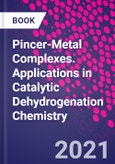Pincer-Metal Complexes: Applications in Catalytic Dehydrogenation Chemistry provides an overview of pincer-metal catalytic systems that transform hydrocarbons and their derivatives from an synthetic and mechanistic point-of-view. This book provides thorough coverage of the operating mechanisms and dehydrogenation catalyst compatibility in both functionalized and unfunctionalized hydrocarbon systems. In addition, it includes success stories of pincer-metal systems, as well as current and future challenges. The book is an ideal reference for researchers practicing synthetic organic chemistry, inorganic chemistry, organometallic chemistry and catalysis in academia and industry.
In recent years there has been a surge in the research on hydrocarbon dehydrogenation catalytic systems that are compatible with polar substituents. This helps facilitate formulation of tandem processes that are not limited to hydrocarbon transformation but also to hydrocarbon functionalization in a single pot.
Please Note: This is an On Demand product, delivery may take up to 11 working days after payment has been received.
Table of Contents
1. Application of Pincer-Metal Complexes in Catalytic Transformations
2. Pincer-group 8 Metal Complexes for Alkane Dehydrogenations
3. Pincer-group 9 Metal Complexes for Alkane Dehydrogenations
4. Pincer-Metal Complexes for Dehydrogenation of Functionalized Hydrocarbons
5. Electro-catalytic (de)hydrogenations using Pincer-Metal Complexes
6. Summary and Outlook








